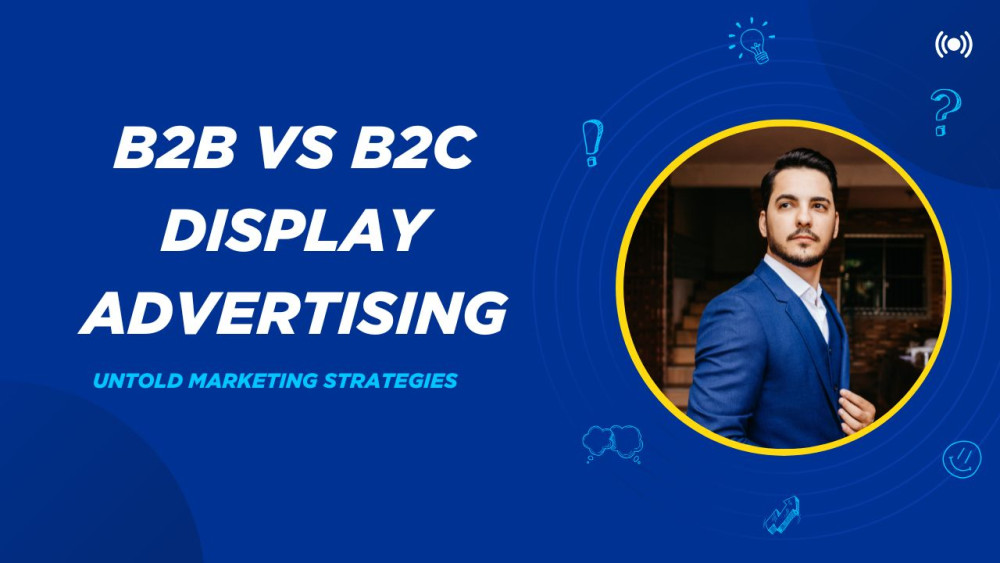1. Audience Targeting & Buyer Journey
B2B: The B2B sales cycle is longer and more complex, often involving multiple decision-makers such as executives, managers, and procurement teams. Display ads need to focus on nurturing leads over time, building credibility, and demonstrating value through thought leadership.
B2C: The B2C purchase cycle is typically shorter, with individual consumers making quick decisions based on emotion, price, and convenience. Display ads are designed to grab attention instantly and drive immediate conversions.
2. Ad Messaging & Tone
B2B: Messaging in B2B display ads is more informational, value-driven, and solution-oriented. The tone is often professional, emphasizing expertise, trust, and return on investment.
B2C: B2C ads focus on emotional triggers, entertainment, and brand appeal. They use persuasive storytelling, urgency (limited-time offers), and engaging visuals to entice consumers.
3. Creative Approach & Design
B2B: B2B display ads prioritize clarity, data-driven content, and a polished, corporate look. Infographics, testimonials, and case studies work well in reinforcing credibility.
B2C: B2C ads are vibrant, visually dynamic, and often feature bold colors, animations, and interactive elements to capture immediate interest.
4. Channels & Placements
B2B: B2B advertisers focus on professional networks (LinkedIn, industry blogs, trade publications) and programmatic display networks that cater to business professionals.
B2C: B2C display ads thrive on high-traffic websites, social media platforms (Facebook, Instagram), entertainment hubs, and lifestyle blogs.
5. Call-to-Action (CTA) Strategy
B2B: CTAs encourage lead generation and long-term engagement, such as “Download Whitepaper,” “Request a Demo,” or “Schedule a Consultation.”
B2C: CTAs drive immediate action, such as “Shop Now,” “Get 50% Off,” or “Sign Up Today.”
Winning Strategies for B2B Display Advertising
Leverage Account-Based Marketing (ABM): Use ABM strategies to serve personalized display ads to high-value target accounts, ensuring messaging aligns with their business needs.
Invest in Retargeting: Since B2B decision-making takes time, retargeting helps keep your brand top-of-mind for users who have previously visited your website.
Utilize LinkedIn & Industry-Specific Sites: LinkedIn’s audience segmentation allows B2B marketers to reach decision-makers based on job title, company size, and industry.
Create Thought Leadership Content: Ads that link to case studies, whitepapers, or webinars help establish brand authority and nurture leads.
Optimize for Lead Generation: Ensure landing pages collect valuable prospect information while offering useful content in return.
Winning Strategies for B2C Display Advertising
Use High-Impact Visuals & Videos: B2C consumers engage more with ads that feature bright, eye-catching designs, motion graphics, and emotionally appealing imagery.
Capitalize on Behavioral Targeting: Leverage data on user browsing history, past purchases, and interests to deliver hyper-personalized display ads.
Implement Time-Sensitive Offers: Creating urgency through flash sales, limited-time discounts, and countdown timers increases conversions.
Leverage Social Proof: Showcase customer reviews, influencer endorsements, and user-generated content to build trust and credibility.
Optimize for Mobile Users: Many B2C consumers engage with ads on mobile devices, so ensure responsive designs and fast-loading pages.
Final Thoughts: Which Approach is Right for Your Business?
Both B2B and B2C display advertising require unique strategies tailored to their specific audience behaviors and goals. B2B display ads focus on long-term relationship-building and data-driven content, while B2C ads prioritize instant engagement and emotional appeal.
Understanding these nuances can help marketers craft highly effective display campaigns that drive results, whether in the corporate world or the fast-paced consumer market. By leveraging data, personalization, and strategic ad placements, businesses can maximize the impact of their display advertising efforts and achieve their marketing objectives.
Are you optimizing your display ads for the right audience?


